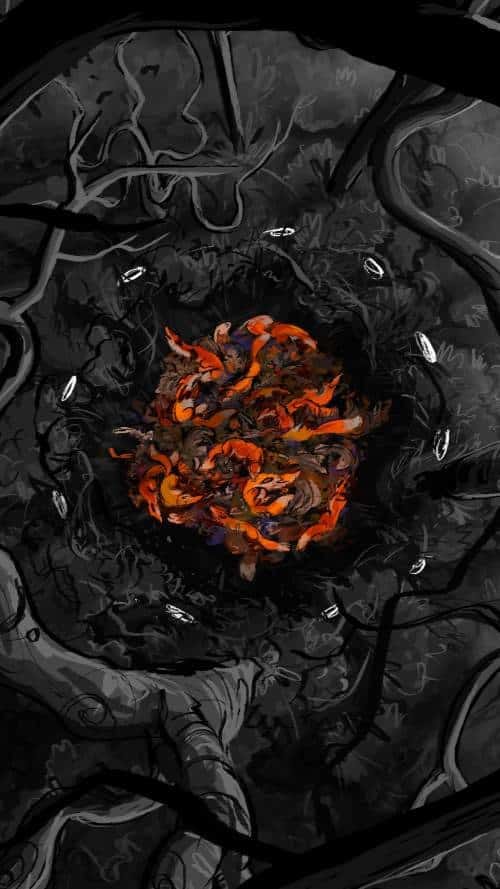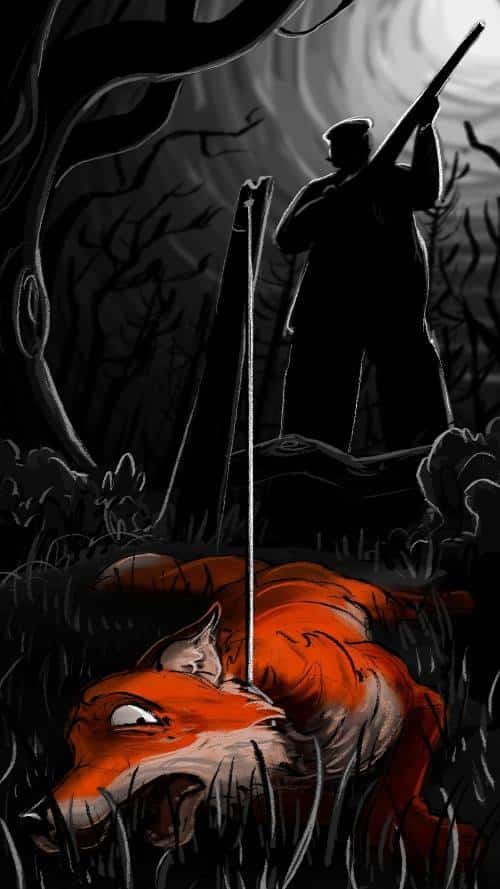"The Shooting Industry: it's not just hunts that kill foxes"
A fox trots through a quiet wood. Suddenly a gun blast tears the air. Pheasant alarm calls ring out. The fox runs as birds are shot out of the sky...
Those are the opening few seconds of a new 90 second animation we're about to launch. It's produced for Protect the Wild by Ben Sinclair of Fire Lily Studio and we've subtitled it, "It's not just hunts that kill foxes". As the animation goes on to explain, the bird shooting industry (a blanket term that includes vast shooting estates, shooting syndicates, and hundreds of gamekeepers) has been waging a war on foxes right across the country. Thousands and thousands of foxes are killed every year - all to 'protect' pheasant, partridges, and grouse until they are shot dead for fun... As the narration says towards the end of the animation, "So much killing. That's not the world I want to live in." https://protectthewild.org.uk/wp-content/uploads/2023/03/PTW_Snaring_v16_instagramtwitter.mp4
A new campaign
A world that sees so much wildlife being killed is not one that many of us want to live in, of course. Pheasants and foxes would certainly prefer a world where they're not shot at. But how many of us really know much about the destruction, cruelty, and wildlife crime that underpins the shooting industry? While illegal fox hunts have rightly been the focus of Protect the Wild and fox lovers everywhere, we now think it's time shooting got the same treatment. Shooting has been getting away with killing birds and mammals (especially foxes) for far too long and with far too little attention put on it. Protect the Wild is determined to 'change the narrative' and - just as we're helping do with fox hunting - bring the shooting industry to an end. But why are we starting with this particular animation? How did we decide on the style and on what to show? We thought our supporters might be interested in hearing about some of the behind-the-scenes thinking that went into the "The Shooting Industry: it's not just hunts that kill foxes" animation.
Tackling the bird shooting industry: the background
About eight weeks ago myself (Charlie Moores) and Rob Pownall (CEO of Protect the Wild) were discussing how we should go about tackling the bird shooting industry. To back up just for a moment, I'd joined Protect the Wild after meeting Rob for the first time last summer. Rob had (in his own words) focussed exclusively on foxes, hunts, and the Hunting Act (firstly as Keep the Ban and now as Protect the Wild) and knew very little about birds or the bird shooting industry. I on the other hand was a lifelong birder and passionately opposed to people shooting them! Would I be interested in joining Protect the Wild and help broaden and expand its work to take on shooting? Yes, I very much would. Now, we both knew that simply launching into shooting campaigns when our existing audience might not be ready for them, probably wasn't going to achieve very much. It would take time. While we thought about how we might one day get the campaign underway, I began writing information for the newly-launched Protect the Wild website, adding Species Accounts which detailed raptor persecution, and an ever-growing page on Bird Shooting FAQs which looked at questions like 'Is bird shooting a 'sport'?' and explaining why we won't support grouse moor licencing and why lead shot must be banned. At the same time, Rob was thinking about animations. He'd already worked with Ben on 'A Trail of Lies' and 'Remember. Remember', both beautifully illustrated and film-like, but each of which had taken Ben almost three months to make. Could they, Rob wondered, be made to the same high standards, but turned around more quickly so that they could become a more regular feature of Protect the Wild's campaigning output?
"The Shooting Industry: it's not just hunts that kill foxes": the background
Which brings us back to eight weeks ago. We felt that what we needed to do was not just suddenly drop the bird shooting industry in front of what was clearly a fox-loving audience, but to take that fox-loving audience with us as we moved along the path towards starting our work on the industry in earnest. We also knew that the shooting industry kills thousands of foxes in snares - far more than hunts do in fact. It often dumps their bodies in stink pits, piles of rotting carcasses ringed by snares used to catch more foxes. It's disgusting and cruel. So, could that be the story we needed to start with...? All three of us thought so. Could we tell that story in under two minutes though, and not take three months to do it? More discussion took place. We decided that we wanted everything kept short, highly-focused, and graphic enough to show the fear of being caught in a snare and shot but not so graphic that people wouldn't watch it (no blood and guts then, for example). The message needed to be accurate and informative and one that would lead viewers to look for more information - which was already waiting for them on our website... Rob and I discussed several ideas for a narration (keep it short, don't over-explain, let the artwork 'speak for itself'), and Ben began a series of sketches for a storyboard. After a week or so Ben sent through a series of short clips. They were (as he saw it) just basic sketches, with very little colour and almost no detail yet in the trees and bushes he imagined the fox running through. But almost as soon as Rob and I saw them, we absolutely loved them. The background looked deliberately blurred, exactly as a woodland might look to someone running through it scared for their life. The fox had been coloured in, and that drew the eye to exactly where it needed to go. We'd already wanted to make sure that the gamekeeper that kills the fox wasn't drawn as a ghoulish caricature, and Ben had delivered a shadowy figure emerging out of the darkness. It already seemed to perfectly sum up how someone checking a snare and came across a trapped fox would look and behave. Could this be the style we wanted, almost arrived at by accident? Ben is a highly-skilled artist and this was not his usual way of doing things. It took a while for us to convince him that we weren't simply trying to save time, that this 'unfinshed' style was genuinely perfect for the campaign. He went away promising to 'think about it', and came back a week later with revised scenes and a growing sense that - like us - this could actually work.

Adding sound
By now the animation had begun to look great, but Ben is not only very proud of his artistic skills he is also a superb sound editor. Earlier animations he'd worked on for Protect the Wild had been perfectly soundtracked, then overlayed with a narration that he'd matched precisely with the visuals. This one was going to be shorter, drawn in a different way, but Ben was determined that it was going to sound just as good as his previous work. I sent him draft recordings of the script that he could use to pace the finished animation against - the fox running, the gunshots etc - and he dived into a library of sounds to add everything from the babbling voices of a distant shooting party, squawking pheasants, and the heavy clump of the gamekeeper's boots, to the near-final sequence of the fox's body landing with a thump in the stink pit pictured above. When he came back with the near-finished film it had been transformed. Already completely clear, we felt, for anyone with hearing loss (Protect the Wild always captions the narrations of course), the whole story now made sense for anyone who might not be able to see what was going on as well. But put together a whole world had been created with pen strokes and layers of sound. Just one thing was missing: a narration... Choosing (and then getting!) the right person to voice a campaign can make a huge difference to how many people are exposed to it. Chris Packham had voiced 'A Trail of Lies'. Megan McCubbin had voiced 'November, November'. Both had done a brilliant job and widely promoted the films on social media, but this time Rob was trying to find someone that wouldn't ordinarily feature in this kind of campaign but who still had the social media clout to get the message across. He'd noticed that Sam Carter, of the band Architects, had followed us and retweeted some of our messaging about hunts. Sam and the band had a massive online presence. Sam himself was charismatic, authentic and believable, and clearly interested in the issues. Would Sam Carter be prepared to do a voiceover for us? Despite being just about to head to Autralia on tour, Sam agreed straight away. He sent over a recording a few days later, and it was great. It's his voice you hear on the final animation, and we couldn't be more thrilled or grateful.
Putting the bird shooting industry in the spotlight
So, that's a brief look at how “The Shooting Industry: it’s not just hunts that kill foxes” came about. What do we hope it will achieve? It won't bring down the bird shooting industry on its own of course. It's very much a first step, but a step that shows the direction we want to go in. Over this coming year we will be working hard to show everyone that no matter what your wildlife interests are - from getting rid of snares and traps to loving foxes or birds - we should all be united in taking down a vile industry that is responsible for so much suffering, cruelty, and death in our countryside. We're now close to ending illegal fox hunting for good. Ending the bird shooting industry will be a long hard fight, one that's really only just beginning, but together we will do it. DONATE TO END BIRD SHOOTING




